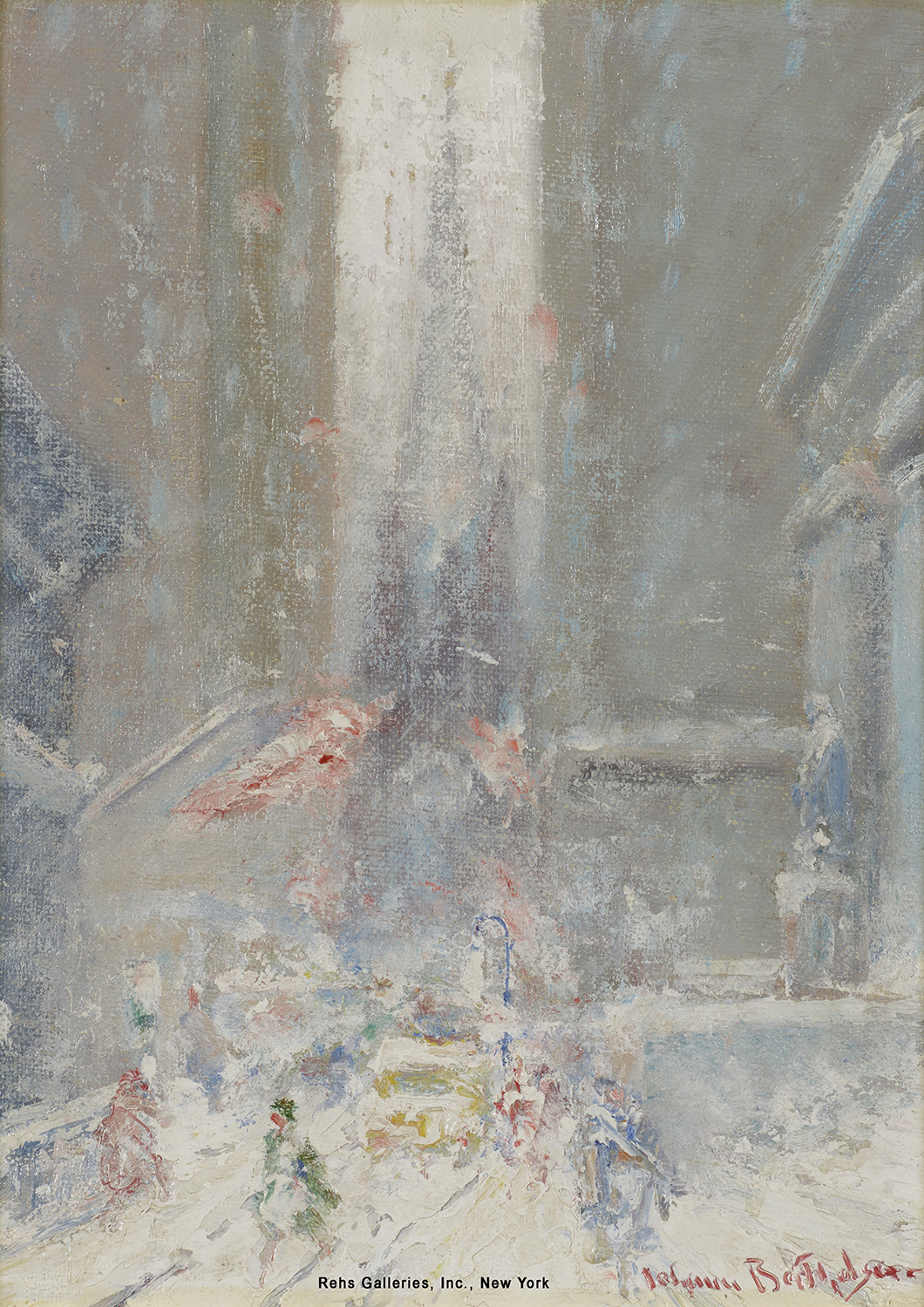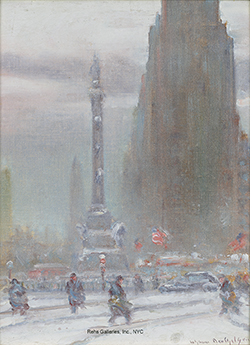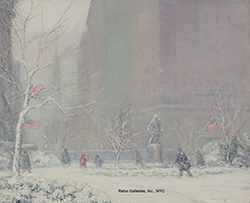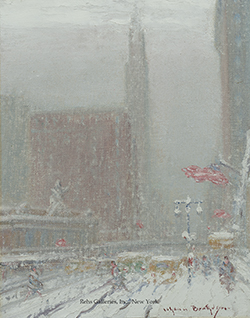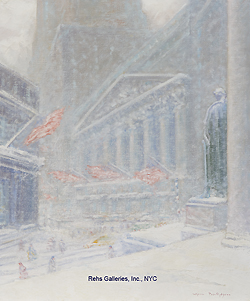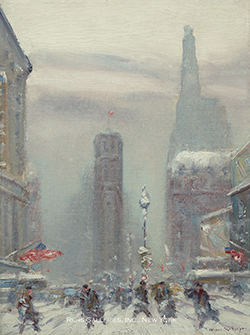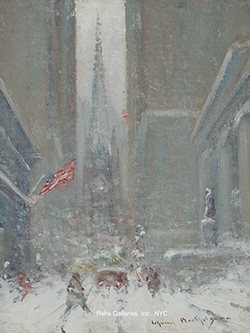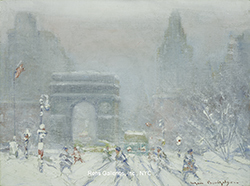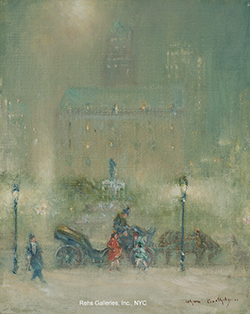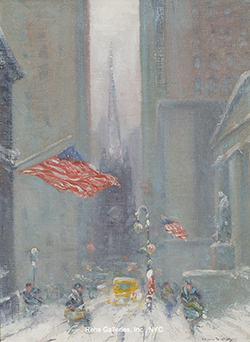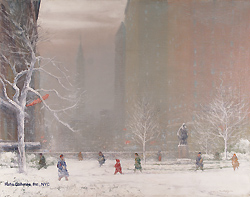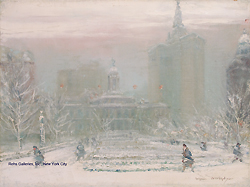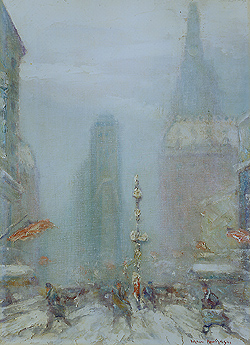Johann Berthelsen - Winter in New York City
A true historical painter, it seems to me, is one who paints the life he sees about him, and so makes a record of his own epoch.
Childe Hassam (1892)
While the Impressionist movement had its roots in France, the once avant-garde style progressively penetrated the American artistic scene. Though initially rejected by American audiences for many of the same reasons as it was initially rejected in France – its unfinished quality, its sketch-like renderings, its rejection of historical narrative – by the 1890s, American artists had embraced the qualities of French Impressionism and translated them for their own works, imbuing their paintings with both a spirit of patriotism and optimism that French Impressionist works occasionally lacked. By the time of Johann Berthelsen’s artistic maturation in the mid-1930s, then, American Impressionism had become well-accepted as audiences were now accustomed to the Impressionist interpretation of the modern scene. By a circuitous route involving intense study of voice and theatrical performance, Berthelsen eventually emerged on the artistic scene, putting forth his own version of American Impressionism with scenes and styles reminiscent of Childe Hassam’s previous paintings. Berthelsen’s urban landscape, especially of New York blanketed in fresh snow, reflected the continuing interest in painting scenes of modern day life heralding the beauty of the often gritty, city environment.
Johann Henrik Carl Berthelsen was not born in the United States, but in Copenhagen, Denmark on July 25th, 1883. He emigrated with his parents to America at the age of seven – an immigration listing reports his arrival in the United States on September 6th, 1890, at the age of seven, most likely not 1889, as has been previously recorded. When he was eighteen years old, Berthelsen entered the Chicago Music College with a full scholarship to study voice. He remained here for four years, graduating in 1905 as a fully trained baritone. After graduating from the Music College, Berthelsen joined a theatrical tour group and began performing opera throughout the United States and Canada. He spent a long five years in the limelight of the theatre, until 1910, when he returned to his alma mater where he became a faculty member. Berthelsen would remain in this position until 1913.
With the emphasis placed on Berthelsen’s training in music, it is surprising that while he was surrounded by the arts, he had sufficient time to pursue other, personal, artistic activities. It has been noted (Leland G. Howard, Johann Berthelsen: An American Master Painter, ex. cat., Sheldon Swope Art Museum: 1988, pg. 5) that an unidentified newspaper clipping stated that while Berthelsen was in Chicago, he came into contact with the Norwegian painter, Svend Svendsen, an artist who often depicted snow scenes, which would later figure as an important component in Berthelsen’s images. It was through Svendsen that Berthelsen may have been introduced to painting. When he relocated to Indianapolis in 1913 to accept a position as the head of the voice department at the Indianapolis Conservatory of Music, he began training under the Indiana-born artist Wayman Adams, a portrait painter who painted at least three portraits of Berthelsen, among other artists and people of the era. Later in his life, Adams became a member of the National Academy of Design in New York City.
Berthelsen left his position at the Conservatory after just two years, opening his own studio in 1915, where he continued to teach voice privately. This must have allowed Berthelsen to engage in many other activities, as he became an active member of the Little Theater Society and held many lead roles in their productions. He additionally began producing paintings under Adams’ tutelage. Adams’ remarked that (quoted in Howard, pg. 6):
It is always a pleasure to see a picture that is not merely technical, but contains the same interest and feeling of an artist for his subject. The intangibly felt nocturnes of Central Park, the romantic streets of New York on a snowy day, or an early spring morning by Mr. Johann Berthelsen, give me great delight. Over many years I have watched the consistent poetic quality of his work and rejoice in his mounting success.
Adams clearly reserved a fair amount of praise for his student. Berthelsen and Adams became so close that they had a double-marriage, each taking their own bride at the same ceremony on October 1st, 1918 in New York City. Berthelsen and his wife later, Helenya, moved to New York City in 1920 and it was at this point that Berthelsen began painting his most recognizable images: those of New York City, with its steel skyscrapers and vibrant lifestyle, shown with a sensitive understanding and rendering of changing environmental elements.
New York was becoming the artistic capital of the world. Its avant-garde artistic trends rivaled, and in many cases, surpassed those of Europe and the fervent speed at which the cityscape continued to develop was proof that the American dream manifests itself socially as well as visually. The city itself provided an opportunity for artists to create captivating images; images of progress and of modernization. To focus on painting the urban cityscape was not a new interest, since the Baudelairean painters of late nineteenth-century France began this trend, but these images produced by American artists taking on the Impressionist palette and subject matter were tinged with a sense of nostalgia and the search for an appropriate method of representing the American cityscape and way of life. Given Berthelsen’s own history as an émigré to America, his images gain special poignancy in relation to depicting a country of hope and prosperity, where man has at his fingertips the opportunities to succeed.
After arriving in New York City in 1920, Berthelsen again opened his own studio where he gave voice lessons, but which also allowed him to begin painting the scenes for which he became best known. He stayed close to his teacher, Adams, as both had studios on West 57th street. Berthelsen experimented with several media during this period, as he was, based on his recognitions and awards, an able pastelist, oil painter, and also watercolorist, gaining entry into the American Watercolor Society in 1926. He continued to maintain ties to Chicago, earning his first official recognition for his work from this city, for a pastel he had completed of Central Park, which was entered in the Hoosier Salon Exhibition in 1928. For this he was given the Albert Erksine Prize for Pastel. It was not until much later, in 1932 and at the age of forty-nine, that Berthelsen chose to devote himself fully to his painting.
By this time, however, the devastating effects of the Depression were felt throughout America. By 1933, very shortly after Berthelsen turned to painting full-time, the unemployment rate in America had jumped to over one-fourth of the American labor force (Marlene Park & Gerald E. Markowitz, New Deal for Art, Hamilton: Gallery Association of New York State, Inc.: 1977, pg. 1). For Berthelsen to turn to the shaky profession of painting during the Depression forces the question of how he was able to fully support himself during this period, especially given that “the unemployment rate for artists was even greater than in the general population.” (Park & Markowitz, pg. 2). Meanwhile, Franklin D. Roosevelt’s election in 1932 signaled a potential change as he, after taking office, instituted the New Deal, including hundreds of art projects begun during the mid-1930s.
Berthelsen, perhaps finding that the beginning of a career of a solo artist was not necessarily the most lucrative position in which to find oneself during a Depression, became involved with some of these projects during the mid-1930s. At least one of the New Deal projects in which he was involved was with the Municipal Art Committee in New York City. Together with eleven other artists, Berthelsen exhibited at the Committee galleries at 62 West 53rd Street.
Berthelsen’s mature style shows the influence of previous American Impressionists such as Childe Hassam, but also recalls the larger issue of the lineage of American Impressionism, going back to France. While American Impressionists may have adopted the French style, it came with new and fresh interpretations (Barbara Weinberg, Doreen Bolger, & David Park Curry, American Impressionism and Realism: The Painting of Modern Life, 1885-1915, ex. cat. New York: Harry N. Abrams, Inc.: 1994, pg. 5):
Like the French, the Americans wished to be of their own time and place, and painters and critics alike saw both the Impressionists and Realists of the United States as helping to reestablish a national artistic voice. Both groups rejected the traditional notion that art must draw its inspiration from myth, religion, history, or other art, inverting the academic emphasis on culture over nature. Like their French predecessors, they recorded the timely moment in contemporary life yet did not renounce a desire to create a timeless art.
While Berthelsen never studied in France, French Impressionist works were first exhibited in America with exhibitions organized by such dealers and Paul Durand-Ruel who, in 1886, brought an enormous amount of paintings to New York and later opened a gallery in New York in 1888 which featured monographic and group exhibitions of many of the leading French Impressionists of the time. (Weinberg, Bolger, & Park Curry, pg. 20) By Berthelsen’s time, French Impressionist paintings could have been found in any number of galleries, exhibitions, or sales in both Chicago and New York. Additionally, other American artists had already taken up the Impressionist style, thus the continuation and knowledge of the Impressionist style is not difficult to find.
Berthelsen’s paintings show his full acceptance of the Impressionist sketch-like rendering and loose paint application, as his figures dissolve into the atmosphere in which he paints them. In many cases, his thinly painted canvases look back even further to the American expatriate painter James McNeill Whistler, while others show an emphasis placed on an impasto technique, creating a unique effect that showed his willingness to experiment with new ways of painting. Edward R. Quick, director of the Sheldon Swope Museum in 1988, recognized that Berthelsen’s interest was “in showing for us the vitality and the spectrum of moods in the life of the city in winter. Where some artists began to delve into its depths, however, Berthelsen went after the luminosity and activity on its streets.” (Howard, pg. 3) Berthelsen would depict the streets of both New York and Chicago throughout his career.
Between 1943 and 1960, Berthelsen exhibited often in New York, Indianapolis, and Chicago, though less frequently in the latter city. Throughout his career, he exhibited in Chicago at the Hoosier Salon and Thurbers Gallery; in Indianapolis at the Hoosier Salon; and in New York City at the American Watercolor Society, Barbizon-Plaza Galleries, Galleries of the Municipal Art Committee, Gatterdam Gallery, and Jean Bohne Gallery. He was additionally a member of the Allied Artists of America, American Watercolor Society, and Salmagundi Club. Between 1942 and 1958, he was the recipient of several awards in Indianapolis. The date of his death is not entirely certain, though he is reported to have died in Wisconsin in 1967, though some recognize his date of death as the year 1969, while others say 1972.
Though coming to painting at a later age and beginning his true artistic career during the time of the great Depression, Berthelsen eventually emerged as an artist who espoused the traditions of the French Impressionists and focused primarily on depicting the urban environment, often including patriotic elements such as an American flag, suggesting that he too rallied for the cause of American patriotism and support of progress. Study of his work is difficult, however, considering that while he signed his works, he rarely, if ever dated them.
The majority of the biographical information in the piece was based on Leland G. Howard’s Johann Berthelsen: An American Master Painter, ex. cat., Sheldon Swope Art museum: 1988.
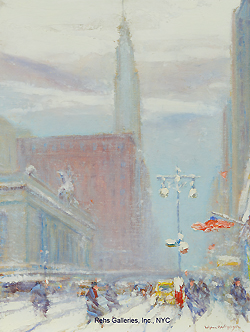 Johann Berthelsen (1883 - 1972) 42nd Looking East, Chrysler Building, Grand Central 16 x 12 inches Signed; also signed and titled on the reverse SOLD Request More Info |
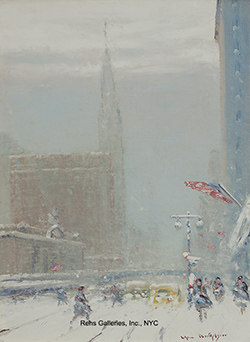 Johann Berthelsen (1883 - 1972) 42nd Street & Vanderbilt Avenue, Grand Central Station 16 x 12 inches Signed SOLD Request More Info |
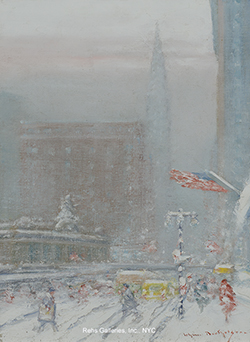 Johann Berthelsen (1883 - 1972) 42nd Street & Vanderbilt Avenue, Grand Central Station 16 x 12 inches SIgned SOLD Request More Info |
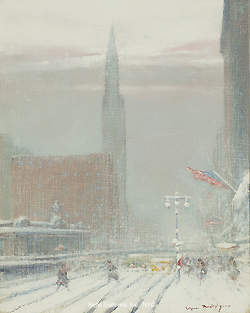 Johann Berthelsen (1883 - 1972) 42nd Street Looking East Past Grand Central Station 20 x 16 inches Signed SOLD Request More Info |
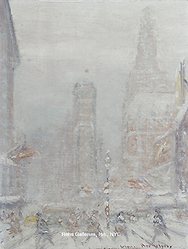 Johann Berthelsen (1883 - 1972) 42nd Street Looking South, Times Square 12 x 9 inches Signed SOLD Request More Info |
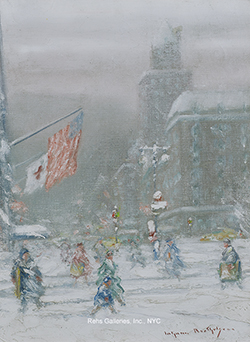 Johann Berthelsen (1883 - 1972) 5th Avenue at 59th Street Looking South 16 x 12 inches Signed SOLD Request More Info |
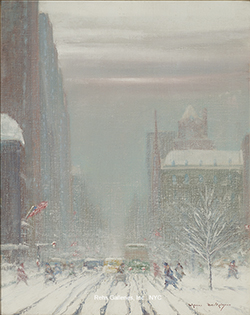 Johann Berthelsen (1883 - 1972) 5th Avenue Looking South from 59th Street 20 x 16 inches Signed SOLD Request More Info |
 Johann Berthelsen (1883 - 1972) 5th Avenue Looking South from 60th Street 16 x 12 inches Signed; also signed and titled on the reverse SOLD Request More Info |
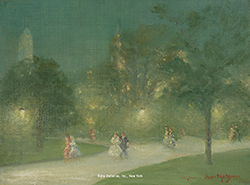 Johann Berthelsen (1883 - 1972) An Evening Walk, Central Park 9 x 12 inches Signed; also signed on the reverse SOLD Request More Info |
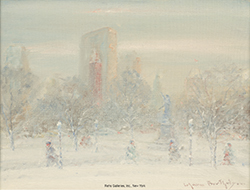 Johann Berthelsen (1883 - 1972) Beginning of the Mall, Central Park, N.Y. 12 x 16 inches Signed; also signed and titled on the reverse SOLD Request More Info |
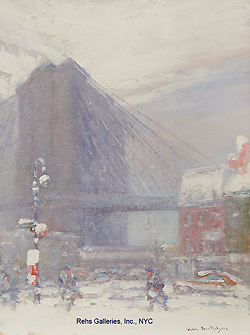 Johann Berthelsen (1883 - 1972) Brooklyn Bridge, Gospel Mission, New York 16 x 12 inches Signed; also signed, titled and dated 1945 on the reverse SOLD Request More Info |
|
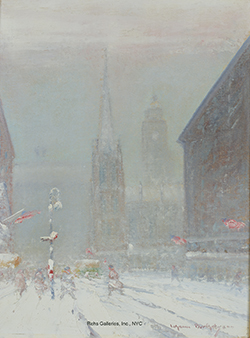 Johann Berthelsen (1883 - 1972) Grace Church 16 x 12 inches Signed; also stamped on the reverse SOLD Request More Info |
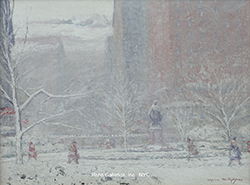 Johann Berthelsen (1883 - 1972) Gramercy Park, Edwin Booth Statue, Looking from the Players Club 12 x 16 inches Signed; also signed and titled on the reverse SOLD Request More Info |
||
 Johann Berthelsen (1883 - 1972) Grand Army Plaza & 59th Street 22 x 28 inches Signed SOLD Request More Info |
 Johann Berthelsen (1883 - 1972) Little Church Around the Corner 16 x 12 inches Signed SOLD Request More Info |
||
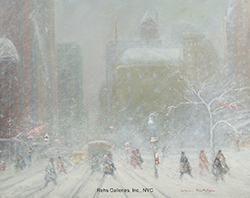 Johann Berthelsen (1883 - 1972) Snowy Day 24 x 30 inches Signed; also signed, titled, and inscribed on the reverse SOLD Request More Info |
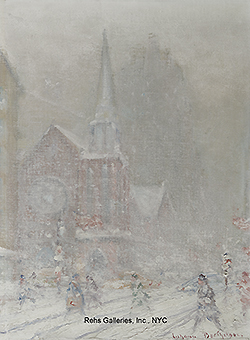 Johann Berthelsen (1883 - 1972) St. James Episcopal Church, 71st Street and Madison Avenue 12 x 9 inches Signed SOLD Request More Info |
 Johann Berthelsen (1883 - 1972) St. Patrick's Cathedral, 5th Avenue 12 x 9 inches Signed SOLD Request More Info |
|
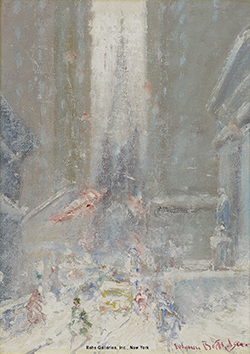 Johann Berthelsen (1883 - 1972) Wall Street, Trinity Church, NY: Treasury Building, Morgan Bank 8 x 6 inches Signed; also signed and titled on the reverse SOLD Request More Info |
|||
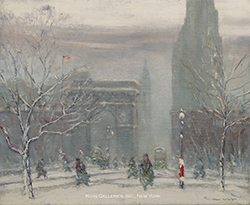 Johann Berthelsen (1883 - 1972) Washington Square Park 20 x 24 inches Signed and dated 1942 SOLD Request More Info |
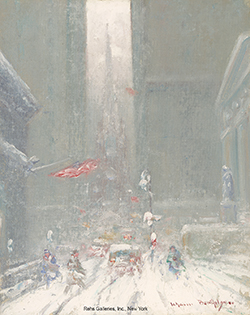 Johann Berthelsen (1883 - 1972) Winter: Wall Street & Trinity Church 10 x 8 inches Signed SOLD Request More Info |
||
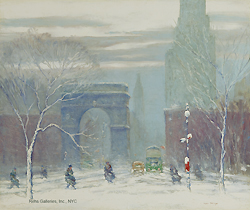 Johann Berthelsen (1883 - 1972) Washington Square in the Snow 25 x 30 inches Signed SOLD Request More Info |
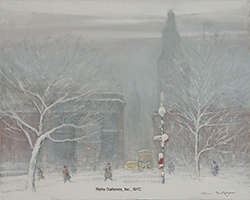 Johann Berthelsen (1883 - 1972) Winter in Washington Square, New York 16 x 20 inches Signed SOLD Request More Info |
||
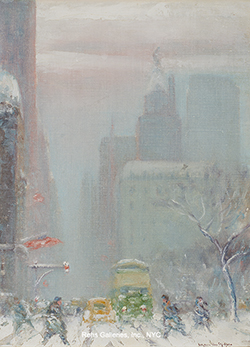 Johann Berthelsen (1883 - 1972) 5th Avenue Looking South, Winter 16 x 12 inches Signed SOLD Request More Info |
 Johann Berthelsen (1883 - 1972) Central Park South: Hampshire House & Sherry Netherland Hotels 16 x 12 inches Signed SOLD Request More Info |
||
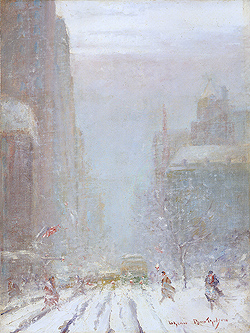 Johann Berthelsen (1883 - 1972) 5th Avenue at 60th Street Looking South 12 x 9 inches Signed SOLD Request More Info |
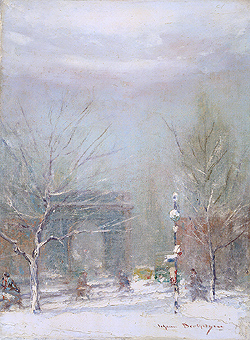 Johann Berthelsen (1883 - 1972) Washington Square Looking North 12 x 9 inches Signed SOLD Request More Info |

